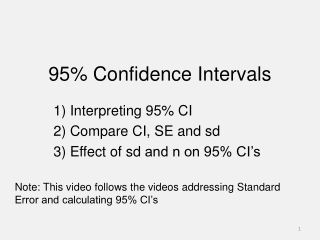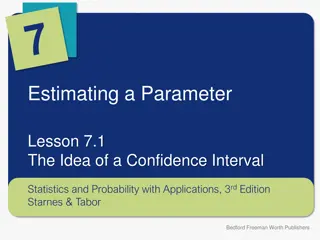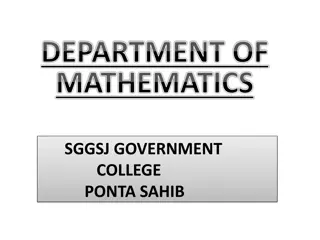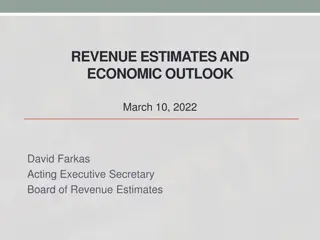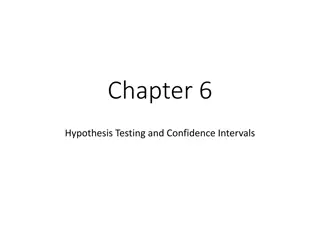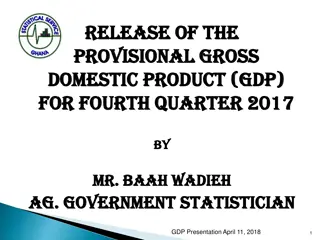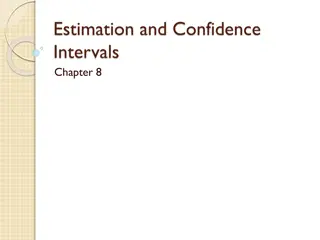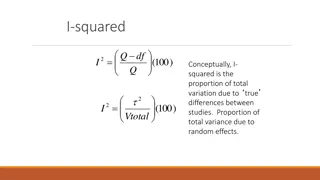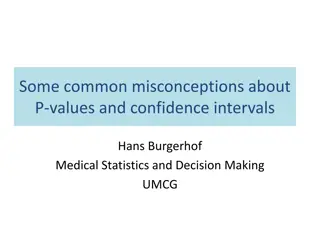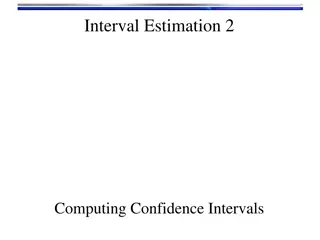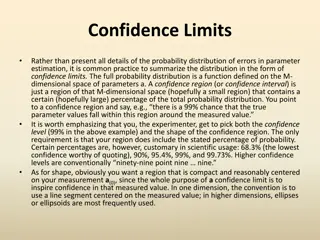Understanding Confidence Intervals and Point Estimates in Statistics
Explore how confidence intervals are constructed around point estimates such as sample mean in statistics. Learn the significance of confidence levels and how to develop confidence intervals using practical examples. Follow step-by-step instructions to analyze data and interpret results for population mean estimates.
Download Presentation

Please find below an Image/Link to download the presentation.
The content on the website is provided AS IS for your information and personal use only. It may not be sold, licensed, or shared on other websites without obtaining consent from the author. Download presentation by click this link. If you encounter any issues during the download, it is possible that the publisher has removed the file from their server.
E N D
Presentation Transcript
Point of Estimate the value of a single sample statistics, such as the sample mean (or the average of the sample data). Confidence Interval range of numbers constructed around the sample mean.
Suppose you want to estimate the mean sales volume of all employees at your company. You select a sample of employees and compute the sample mean of $20,000. The mean sales volume for all employees is an unknown population mean. As a point estimate of the population mean, you ask how accurate is the number as an estimate of the population mean. account the known variability from sample to sample, you can construct a confidence interval for the population mean to answer these questions. By taking into
When we indicate a confidence level, such as 95% confidence level, that means that if we selected all of the possible samples of a population, then 95% of the intervals developed would include the point of estimate somewhere within the range.
Lets take a look at an example of developing a confidence interval. Listed below are the overall miles per gallon of a 2009 small SUVs priced under $30,000: 24,23,22,21,22,22,18,19,19,21,21,21,18,19, 21,17,22,18,18,22,16,16 a) Construct a 95% confidence internal estimate for the population mean MPG of 2009 SUVs priced under $30,000. b) Interpret the interval constructed in (a).
Step 1 Insert the data into Excel. Your screen should look like this:
Step 2 Run the descriptive statistics. Descriptive Statistics Go to data Data Analysis For Input Range, select Cells A1 through A22 Check the Summary Statistics Box Check the Confidence Level for Mean box and type in 95% (Note: You can type in any percentage but this problem asks us to construct the 95% confidence interval.)
Your inputs should look like this:
Column1 Mean Standard Error Median Mode Standard Deviation Sample Variance Kurtosis 20 0.487950036 21 22 2.288688541 5.238095238 -0.98107177 After you click OK, the descriptive statistics are provided: Skewness Range Minimum Maximum Sum Count Confidence Level(95.0%) -0.235942982 8 16 24 440 22 1.014747648
Construct the upper and lower limits of the confidence interval. Step 3 Upper Limit = Mean (20) + Confidence Level (1.01) = 21.01 Average = Mean (20) = 20 Lower Limit = Mean (20) Confidence Level (1.01) = 18.99 So the way you write the 95% confidence interval is: 18.99 ? 21.01
For Part B, to interpret the results, you would state that: You can be 95% confidence that the average miles per gallon of 2009 small SUVs priced under $30,000 is somewhere between 18.99 and 21.01.
Determining Sample Size for the Population Mean In the problem above, the sample size was provided to you. In the business world, sample sizes are determined prior to data collection to ensure the confidence interval is narrow enough to be useful in making decisions. Determining the proper sample size can be complicated, subject to constraints in the budget, time, and the amount of acceptable sampling error. You must also determine, in advance, the level of confidence to use in estimating the population parameters.
In statistics, sampling error is incurred when the statistical characteristics of a population are estimated from a subset, or sample, of that population. Since the sample does not include all members of the population, statistics on the sample, such as means, generally differ from parameters on the entire population. For example, if one measures the height of a thousand individuals from a country of one million, the average height of the thousand is typically not the same as the average height of all one million people in the country.
To compute the appropriate sample size you need to know the following: The desired confidence level (90%, 95%, 99%) 1 The acceptable sampling error 2 3 The standard deviation
Illustration A consumer group would like to estimate the mean monthly electricity charge for a single family house in July within $5 using a 99% level of confidence. Based upon similar studies the standard deviation is estimated to be $20.00. How large of a sample is required for this study to be valid?
Key Components: Sample Error Sample Standard Deviation Level of Confidence $5.00 $20.00 99%
Solution in Excel The z value, or standard score, indicates by how many standard deviationsan observation is above or below the mean. Attached is a copy of the Excel sheet with formulas already computed.
Determining Sample Size for the Proportion Supposed you want to determine the sample size necessary for estimate a population proportion. To determine sample size, you must know three factors: 1 The desired confidence level The acceptable standard error 2 3 The population proportion
Illustration A political pollster wants to estimate the proportion of voters who will vote for the Republican candidate in a U.S. presidential election. The pollster wants to have 90% confidence that her prediction is correct to within 0.04 of the population proportion. What sample size is needed? Previous studies have concluded that the errors are within .01.


